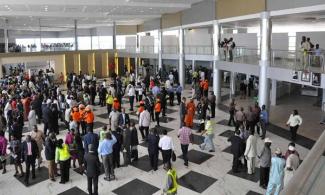
However, the data released today by NCAA is contrary to one released earlier in the year by the National Bureau of Statistics (NBS), which put the total traffic for 2017 at 13,394,945, out of which 6,693,687 were arrivals and 6,701,258 were departing passengers.

A report obtained from the website of the Nigerian Civil Aviation Authority (NCAA) has put the total number of air travellers who passed through the 30 Nigerian airports and airstrips in 2017 at 14, 440,169.
The report put the domestic passengers (arrival and departure) at 10,383,452 and the international passengers (arrival and departure) at 4,056,717.
Just like in the past, the Murtala Muhammed Airport (MMA), Lagos, had the highest passenger traffic on both local and international routes, with 3,684,052 and 2,869,099 passengers respectively.
The international traffic from the airport represented over 55 percent of international travels through the nation’s airports.
Lagos was followed on the domestic routes by Abuja airport, which had 2,826,113 passenger movements, Port Harcourt Airport with 865,659 and Owerri with 416,300 passenger movements within the period.
On the foreign scene, Abuja came a distant second to Lagos, with 734,509 arrival and departure passengers, while Kano was ahead of Port Harcourt and came third with 186,795 passenger movements. Port Harcourt had 81,125 passengers within the period under review.
The breakdown of the domestic travel showed that Calabar, Maiduguri, Sokoto, Ilorin, Yola, Kaduna, Katsina, Minna, Gombe, Enugu, Akure and Benin had 157,208, 142,503, 61,958, 93,834, 135,704, 354,089, 2,425, 7,213, 27,606, 279,673,26,384 and253,780 passenger movements in 2017 respectively.
Others within the period were Eket, Ibadan, Jos, Kano, Osubi, Zaria, Bauchi, Escravos, Akwa Ibom, Asaba, Finima, Forcados, Kebbi and Dutse with 17,720, 64,370, 55,177, 253,578, 158,879, 574, 4,541, 187,878, 191,133, 29,778, 64,545, 1,591, 18,504 and 693 respectively of both arrivals and departures on the local scene.
Only Makurdi did not record any domestic passenger movements in 2017, both at local and international scenes.
On the international scene, according to the report, 4,056,717 passengers moved through 18 airports across the country in 2017, with the least being 25 passengers from Calabar Airport.
Apart from the aforementioned airports, Lagos, Abuja, Kano and Port Harcourt, which recorded movements of 3,871,528 passengers, representing 95.4 percent of the total international traffic, the other 14 airports recorded just 185,189 passengers, which was just 4.6 percent traffic within the period.
Airports like Maiduguri, Sokoto, Ilorin, Yola, Kaduna, Katsina, Minna Gombe and Enugu had 7,762, 20,495, 6,058, 11,428, 9,167, 9,556, 4,888 and 41,344 passenger movements in 2017.
Other airports are Bauchi, Akwa Ibom, Kebbi and Dutse with 9,523, 47, 14,385 and 3,679 passengers respectively in the outgone year.
However, the data released today by NCAA is contrary to one released earlier in the year by the National Bureau of Statistics (NBS), which put the total traffic for 2017 at 13,394,945, out of which 6,693,687 were arrivals and 6,701,258 were departing passengers.
There is, however, a disparity of 1,045,224 passengers between the statistics released by NCAA and NBS.
According to NBS, Lagos, Abuja, Port Harcourt, Owerri and Kano airports were the busiest through the year of 2017. NBS said passengers travelled through Abuja airport largely increased from Q1 (577,386 domestic and 692,207 international) to Q2 (841,401 domestic and 231,414 international) due to the reopening of the Abuja airport.
Kaduna airport recorded higher-than-usual numbers of domestic traffic in the first two quarters of 2017 (124,996 in Q1 and 129,034 in quarter two) since a large proportion of air traffic through Abuja was redirected to Kaduna after the closure of Abuja airport in March 2017.